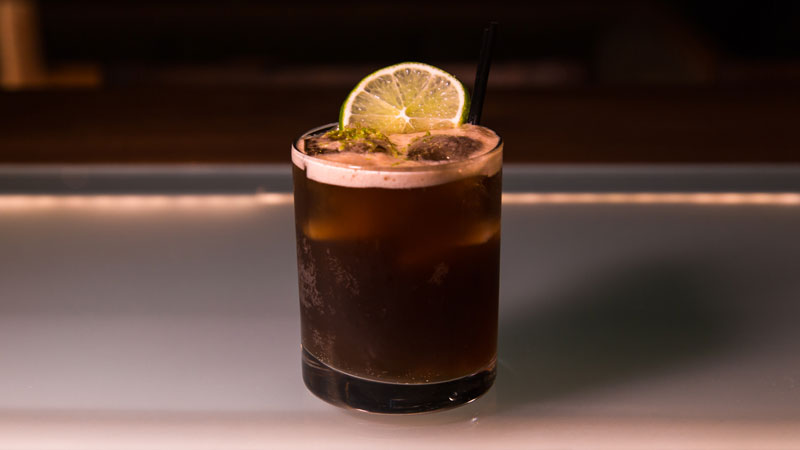Marmite is not for everyone. The dark, viscous sandwich spread made from excess brewers’ yeast has a cult following in its native Great Britain, but is often deemed too salty, pungent, or sour by those of us who didn’t grow up spreading it on toast each morning.
Erich Hehn, the 36-year-old bartender at District Saigon in Queens, N.Y., first tasted Marmite while teaching English as a second language in Korea. “On my first try, I was startled,” Hehn says with a mock grimace. “But on the second try, I was in love — and couldn’t stop thinking about it.”
Now Hehn is a passionate Marmite emissary. He believes that, when used carefully, Marmite can create distinctly umami flavors in cocktails, much in the manner of mushrooms and bacon. He is leading the charge to take Marmite out of English kitchens and into bartenders’ arsenals.
At District Saigon, Hehn turns pungent Marmite into cocktail-friendly syrups that produces drinks with a distinctly umami bite. The Trust Buster, his signature Marmite cocktail, is made with rum, cachaca, grapefruit liqueur, Coke, chocolate bitters, and Hehn’s custom creation, the crucial Marmite syrup.
“It has a nice balance of saltiness that leaves your mouth a bit dry at the end,” Hehn says. “It’s a riff on a rum and Coke that goes in a salty, caramel direction,” he adds.

After reading about how the Highball had become such an enormous cocktail trend in Japan, Hehn was inspired “to start playing around with the idea of kind of kitschy drinks,” he says. Originally, he tried to infuse a Rob Roy with a kick of Marmite, but the results were “too intense,” he recalls. Rum and Coke, however, is “a good simple drink to begin with,” Hehn says.
The syrup features a two-to-one ratio of water to Marmite, with a dash of sugar for balance. It provides a savory backbone to the rum and Coke, connecting lighter, floral notes to a salty anchor.
The Trust Buster has been on District Saigon’s menu for a year now, and it’s proven to be a solid performer. Marmite syrup also features in Java The Hutt, a creation of Hehn’s colleague, bartender May Yu, made with cold brew coffee and banana liqueur.
Explaining the cocktails’ key ingredient to customers can require a degree of diplomacy, Hehn says. He avoids the phrase “yeast extract” in favor of playing up the drink’s salty, caramel quality. For patrons deeper into food culture, he mentions the umami dimension.
Called the “fifth taste,” after salty, sour, sweet, and bitter, umami is commonly associated with things like bacon and mushrooms. Other, savory-leaning drinks on District Saigon’s menu, like those made with housemade, shiitake-mushroom-infused blended Scotch, also fall into the category.
Umami flavor profiles have been widely embraced across the food world, but yeast extract remains an under-explored ingredient in drinks creations. An Instagram search for the hashtag “Marmite cocktail” produces just seven returns — and three of them are people sipping other drinks out of repurposed Marmite jars.
Mixologist Matt Whiley’s now-shuttered London bar, Peg + Patriot, featured a Marmite Martini on its menu at the end of last year. In it, a yeast extract distillate played alongside vodka, vermouth, lemon, and absinthe. London’s Duck and Waffle has served a drink called the Marmite Black Velvet on its seasonal cocktail menu. It pairs the product with Guinness syrup and Champagne.

Others infuse Marmite into Bloody Marys, where it plays beautifully off salty-sweet tomato juice and spice. It makes practical sense, too. Marmite is a common breakfast condiment in Great Britain, and it is believed to help assuage hangovers by virtue of its vitamin B12 and salt content. (Do not look at the nutritional information on a jar of Marmite if you are at all concerned about your sodium intake.)
Overcoming the misconception that yeast extract is an off-putting, peculiar foodstuff is key to furthering Marmite’s capabilities as a cocktail ingredient. There’s nothing particularly strange about the way Marmite’s salty base complements other flavors, especially when it’s used to balance out sweet drinks with a savory, smoky underbelly.
It’s similar to the ways cooks combine fish sauce — another umami powerhouse, made with fermented black anchovies —with lime juice and sugar to create the basis of a fresh and zesty dipping sauce. Diners who might think they’re averse to anchovies will enthusiastically sop up the resulting blend, even if they might not be enthralled at discovering the ingredients list.
Undeterred, Hehn says he’ll continue to champion its charms as a cocktail ingredient.
“People who love Marmite think the drinks are f-ckin’ great,” he says. “I’ll always have Marmite syrup on hand.”
